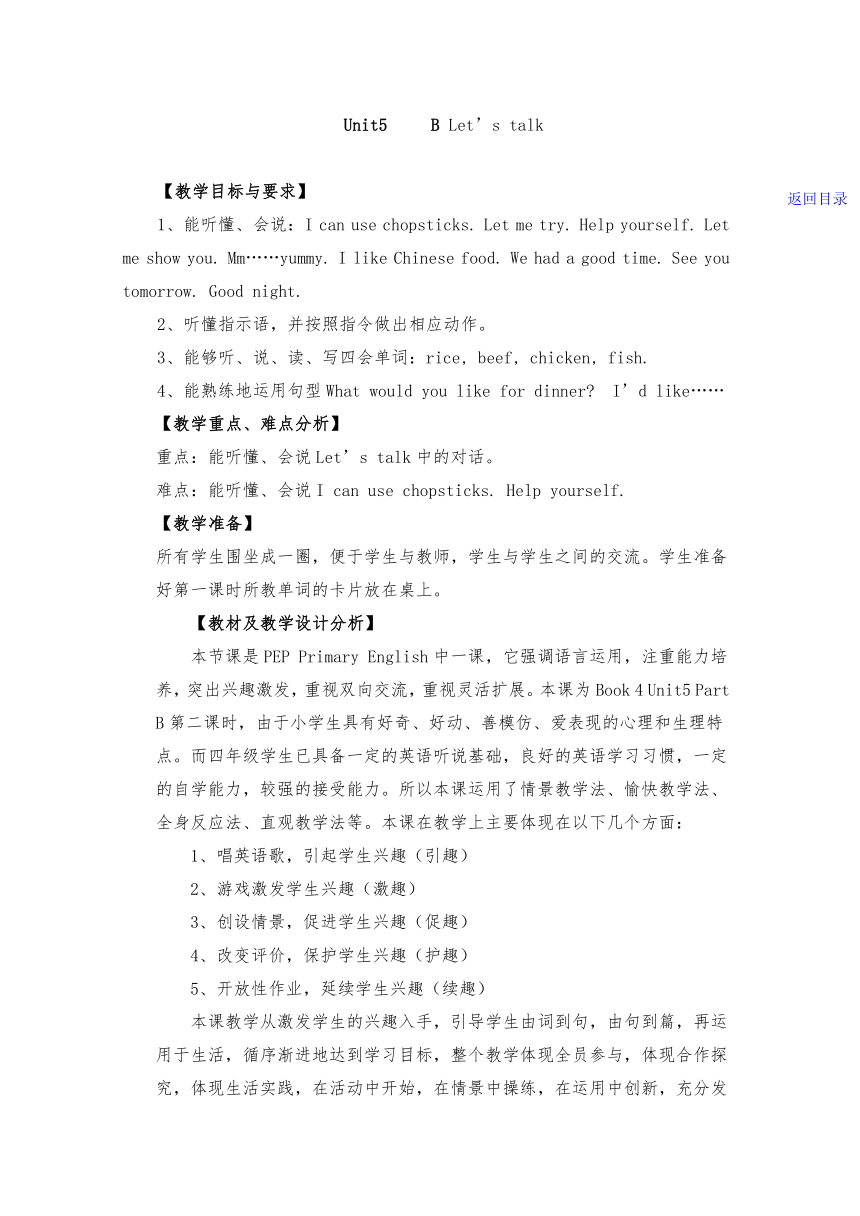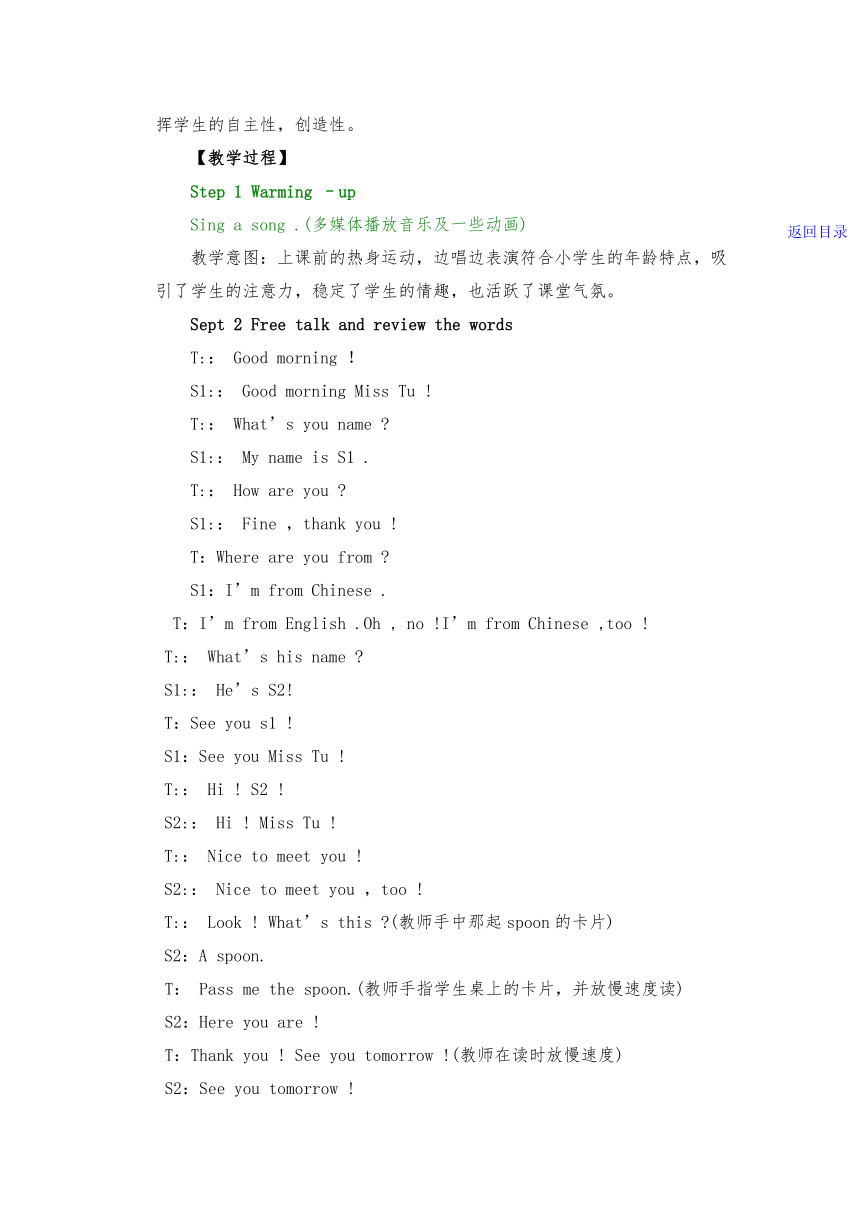unit 5 what would you like? Part B let’s talk
文档属性
| 名称 | unit 5 what would you like? Part B let’s talk |  | |
| 格式 | zip | ||
| 文件大小 | 15.2KB | ||
| 资源类型 | 教案 | ||
| 版本资源 | 人教版(PEP) | ||
| 科目 | 英语 | ||
| 更新时间 | 2012-11-23 15:26:23 | ||
图片预览


文档简介
Unit5 B Let’s talk
【教学目标与要求】
1、能听懂、会说:I can use chopsticks. Let me try. Help yourself. Let me show you. Mm……yummy. I like Chinese food. We had a good time. See you tomorrow. Good night. 2、听懂指示语,并按照指令做出相应动作。
3、能够听、说、读、写四会单词:rice, beef, chicken, fish.
4、能熟练地运用句型What would you like for dinner? I’d like……
【教学重点、难点分析】 重点:能听懂、会说Let’s talk中的对话。 难点:能听懂、会说I can use chopsticks. Help yourself. 【教学准备】 所有学生围坐成一圈,便于学生与教师,学生与学生之间的交流。学生准备好第一课时所教单词的卡片放在桌上。 【教材及教学设计分析】 本节课是PEP Primary English中一课,它强调语言运用,注重能力培养,突出兴趣激发,重视双向交流,重视灵活扩展。本课为Book 4 Unit5 Part B第二课时,由于小学生具有好奇、好动、善模仿、爱表现的心理和生理特点。而四年级学生已具备一定的英语听说基础,良好的英语学习习惯,一定的自学能力,较强的接受能力。所以本课运用了情景教学法、愉快教学法、全身反应法、直观教学法等。本课在教学上主要体现在以下几个方面: 1、唱英语歌,引起学生兴趣(引趣) 2、游戏激发学生兴趣(激趣) 3、创设情景,促进学生兴趣(促趣) 4、改变评价,保护学生兴趣(护趣) 5、开放性作业,延续学生兴趣(续趣) 本课教学从激发学生的兴趣入手,引导学生由词到句,由句到篇,再运用于生活,循序渐进地达到学习目标,整个教学体现全员参与,体现合作探究,体现生活实践,在活动中开始,在情景中操练,在运用中创新,充分发挥学生的自主性,创造性。 【教学过程】 Step 1 Warming –up Sing a song .(多媒体播放音乐及一些动画) 教学意图:上课前的热身运动,边唱边表演符合小学生的年龄特点,吸引了学生的注意力,稳定了学生的情趣,也活跃了课堂气氛。 Sept 2 Free talk and review the words T:: Good morning ! S1:: Good morning Miss Tu ! T:: What’s you name ? S1:: My name is S1 . T:: How are you ? S1:: Fine ,thank you ! T:Where are you from ? S1:I’m from Chinese . T:I’m from English .Oh , no !I’m from Chinese ,too ! T:: What’s his name ? S1:: He’s S2! T:See you s1 ! S1:See you Miss Tu ! T:: Hi ! S2 ! S2:: Hi ! Miss Tu ! T:: Nice to meet you ! S2:: Nice to meet you ,too ! T:: Look ! What’s this ?(教师手中那起spoon的卡片) S2:A spoon.
T: Pass me the spoon.(教师手指学生桌上的卡片,并放慢速度读) S2:Here you are ! T:Thank you ! See you tomorrow !(教师在读时放慢速度)
S2:See you tomorrow ! T:Good morning ! S3:Good morning! T:Pass me the chopsticks ! S3:Here you are! T:Good night!(教师用肢体语言表示意思,并放慢速度读) S:Good night !(教师引导学生说)
(Use the same way to review the words:knife fork soup fish beef rice vegetable noodles and so on ) 教学意图:教师以朋友的语气与学生交流,能消除学生的紧张情绪。师生间会话,不仅复习了已学的旧知识,起到温故而知新的作用,而且为chant中的Pass me the ___句型与Good night! See you tomorrow! Chinese food ; English food做铺垫。 Step 3 Presentation
呈现教师一天三餐的表格
rice
vegetable
milk
soup
fish
chicken
bread
beef
noodles
breakfast
√
√
Lunch
√
√
√
√
dinner
√
√
√
√
T: I’d like milk and bread for breakfast.
I’d like rice, fish, chicken and beef for dinner.
(呈现图片和单词,学生书空)
(通过师生对话引出本课时的四会单词和重点句型,过渡自然)
Chant
I love rice and beef.
Would you like to come with me?
I love chicken and fish.
Would you want to come with me?
改编chant,记忆四会单词。
通过chant 的形式让学生记忆本课单词,符合他们爱唱爱玩的性格特点,鲜明的节奏让学生体验到学习的快乐。
Step 4 Practice
1、“我是记忆能手”竞赛补充单词,例如:
m k b f f s h ch ck
il r a i sh i c en
(利用竞赛形式帮助学生记忆单词,比枯燥的直接拼读方法更容易让学生接受。)
2、传单词游戏:
全部同学站立,每组第一个同学到老师里抽一个单词,然后用手指在同学背后写单词,依次把单词传下去,最后一个同学把单词写在黑板上,最快又写对了的那组就赢。
Step 5 Let’s do 1、T:Are you happy ? We had a good time .(读We had a good time . 时放慢语速,以便学生听清正确发音,并用肢体语言表示其意) T:This meaning is we had a good time . Guess . What’s the meaning ?(教师做课文中Let’s do中的wash the plate 的动作) S:Wash the plate. T:I can wash the plate .Can you ?(放慢语速,以便学生听清楚正确发音,让学生初步接触I can ____.的句型。为I can use chopsticks的教学做铺垫。) Ss:Yes , I can .(课件中同时出现wash the plate) T:What’s the meaning ?(教师做use the chopsticks的动作) S:Use the chopsticks .(同时课件出示use the chopsticks) T:I can use chopsticks . Can you ?(读I can use chopsticks.时放慢语速,以便学生听清发音,为进一步的教学做铺垫) S:Yes. I can use chopsticks .(教师引导学生) T:Who wants to have a try ? S:Me . T:You can say let me try !(为整个课堂中学生要求发言时便说Let me try ,更为Let me try的教学做铺垫) S:Let me try . 。。。。。。 T:you can use chopsticks . 2、小 小 记 者 站 forkspoonknifechopsticksanother I can use … 【板书设计】
Unit 5 What Would You Like?
What would you like for dinner?
I’d like…..
【教学目标与要求】
1、能听懂、会说:I can use chopsticks. Let me try. Help yourself. Let me show you. Mm……yummy. I like Chinese food. We had a good time. See you tomorrow. Good night. 2、听懂指示语,并按照指令做出相应动作。
3、能够听、说、读、写四会单词:rice, beef, chicken, fish.
4、能熟练地运用句型What would you like for dinner? I’d like……
【教学重点、难点分析】 重点:能听懂、会说Let’s talk中的对话。 难点:能听懂、会说I can use chopsticks. Help yourself. 【教学准备】 所有学生围坐成一圈,便于学生与教师,学生与学生之间的交流。学生准备好第一课时所教单词的卡片放在桌上。 【教材及教学设计分析】 本节课是PEP Primary English中一课,它强调语言运用,注重能力培养,突出兴趣激发,重视双向交流,重视灵活扩展。本课为Book 4 Unit5 Part B第二课时,由于小学生具有好奇、好动、善模仿、爱表现的心理和生理特点。而四年级学生已具备一定的英语听说基础,良好的英语学习习惯,一定的自学能力,较强的接受能力。所以本课运用了情景教学法、愉快教学法、全身反应法、直观教学法等。本课在教学上主要体现在以下几个方面: 1、唱英语歌,引起学生兴趣(引趣) 2、游戏激发学生兴趣(激趣) 3、创设情景,促进学生兴趣(促趣) 4、改变评价,保护学生兴趣(护趣) 5、开放性作业,延续学生兴趣(续趣) 本课教学从激发学生的兴趣入手,引导学生由词到句,由句到篇,再运用于生活,循序渐进地达到学习目标,整个教学体现全员参与,体现合作探究,体现生活实践,在活动中开始,在情景中操练,在运用中创新,充分发挥学生的自主性,创造性。 【教学过程】 Step 1 Warming –up Sing a song .(多媒体播放音乐及一些动画) 教学意图:上课前的热身运动,边唱边表演符合小学生的年龄特点,吸引了学生的注意力,稳定了学生的情趣,也活跃了课堂气氛。 Sept 2 Free talk and review the words T:: Good morning ! S1:: Good morning Miss Tu ! T:: What’s you name ? S1:: My name is S1 . T:: How are you ? S1:: Fine ,thank you ! T:Where are you from ? S1:I’m from Chinese . T:I’m from English .Oh , no !I’m from Chinese ,too ! T:: What’s his name ? S1:: He’s S2! T:See you s1 ! S1:See you Miss Tu ! T:: Hi ! S2 ! S2:: Hi ! Miss Tu ! T:: Nice to meet you ! S2:: Nice to meet you ,too ! T:: Look ! What’s this ?(教师手中那起spoon的卡片) S2:A spoon.
T: Pass me the spoon.(教师手指学生桌上的卡片,并放慢速度读) S2:Here you are ! T:Thank you ! See you tomorrow !(教师在读时放慢速度)
S2:See you tomorrow ! T:Good morning ! S3:Good morning! T:Pass me the chopsticks ! S3:Here you are! T:Good night!(教师用肢体语言表示意思,并放慢速度读) S:Good night !(教师引导学生说)
(Use the same way to review the words:knife fork soup fish beef rice vegetable noodles and so on ) 教学意图:教师以朋友的语气与学生交流,能消除学生的紧张情绪。师生间会话,不仅复习了已学的旧知识,起到温故而知新的作用,而且为chant中的Pass me the ___句型与Good night! See you tomorrow! Chinese food ; English food做铺垫。 Step 3 Presentation
呈现教师一天三餐的表格
rice
vegetable
milk
soup
fish
chicken
bread
beef
noodles
breakfast
√
√
Lunch
√
√
√
√
dinner
√
√
√
√
T: I’d like milk and bread for breakfast.
I’d like rice, fish, chicken and beef for dinner.
(呈现图片和单词,学生书空)
(通过师生对话引出本课时的四会单词和重点句型,过渡自然)
Chant
I love rice and beef.
Would you like to come with me?
I love chicken and fish.
Would you want to come with me?
改编chant,记忆四会单词。
通过chant 的形式让学生记忆本课单词,符合他们爱唱爱玩的性格特点,鲜明的节奏让学生体验到学习的快乐。
Step 4 Practice
1、“我是记忆能手”竞赛补充单词,例如:
m k b f f s h ch ck
il r a i sh i c en
(利用竞赛形式帮助学生记忆单词,比枯燥的直接拼读方法更容易让学生接受。)
2、传单词游戏:
全部同学站立,每组第一个同学到老师里抽一个单词,然后用手指在同学背后写单词,依次把单词传下去,最后一个同学把单词写在黑板上,最快又写对了的那组就赢。
Step 5 Let’s do 1、T:Are you happy ? We had a good time .(读We had a good time . 时放慢语速,以便学生听清正确发音,并用肢体语言表示其意) T:This meaning is we had a good time . Guess . What’s the meaning ?(教师做课文中Let’s do中的wash the plate 的动作) S:Wash the plate. T:I can wash the plate .Can you ?(放慢语速,以便学生听清楚正确发音,让学生初步接触I can ____.的句型。为I can use chopsticks的教学做铺垫。) Ss:Yes , I can .(课件中同时出现wash the plate) T:What’s the meaning ?(教师做use the chopsticks的动作) S:Use the chopsticks .(同时课件出示use the chopsticks) T:I can use chopsticks . Can you ?(读I can use chopsticks.时放慢语速,以便学生听清发音,为进一步的教学做铺垫) S:Yes. I can use chopsticks .(教师引导学生) T:Who wants to have a try ? S:Me . T:You can say let me try !(为整个课堂中学生要求发言时便说Let me try ,更为Let me try的教学做铺垫) S:Let me try . 。。。。。。 T:you can use chopsticks . 2、小 小 记 者 站 forkspoonknifechopsticksanother I can use … 【板书设计】
Unit 5 What Would You Like?
What would you like for dinner?
I’d like…..
